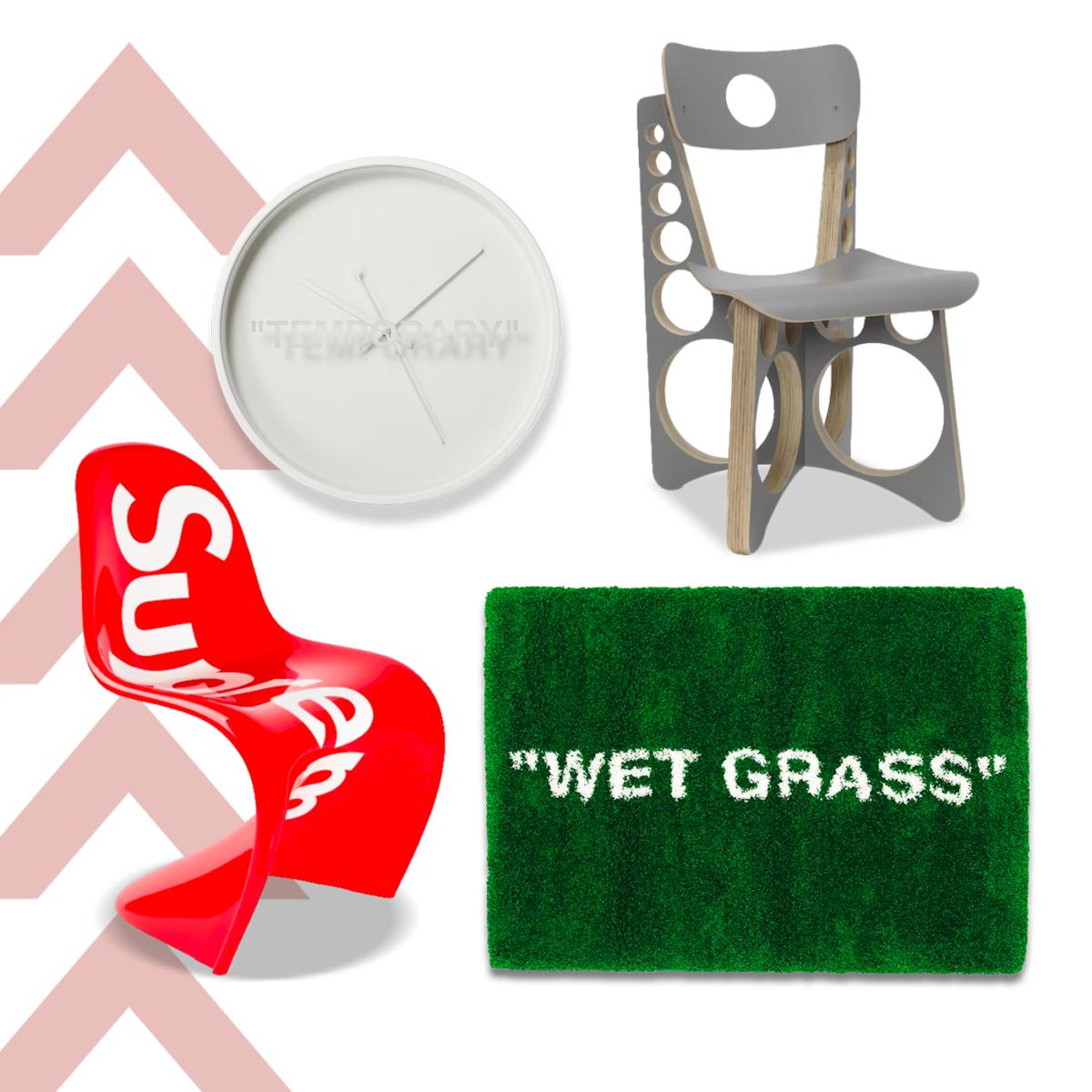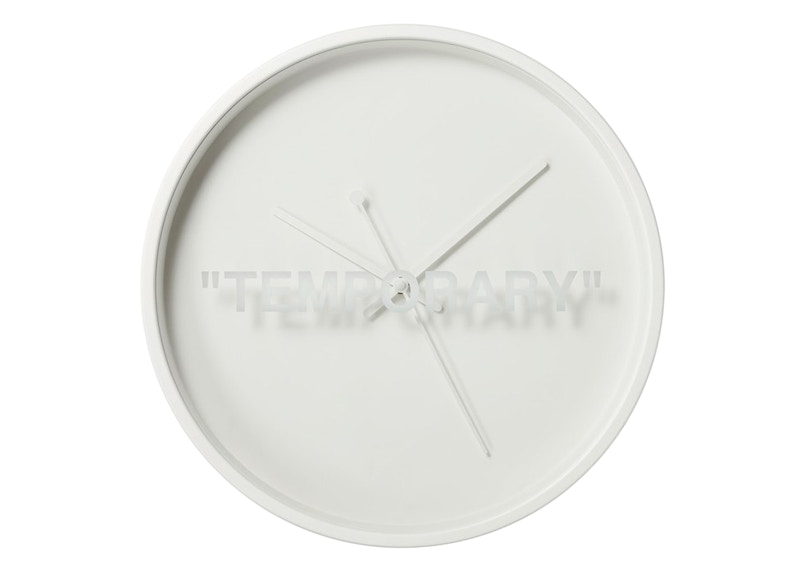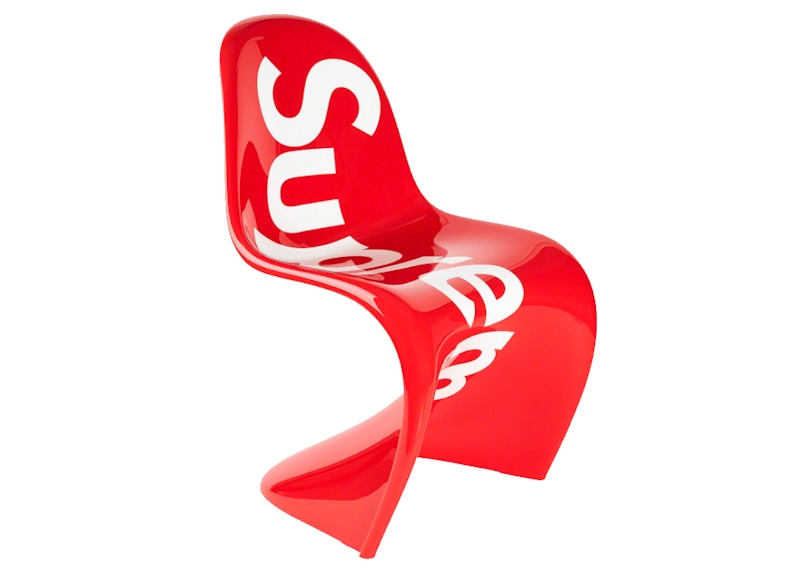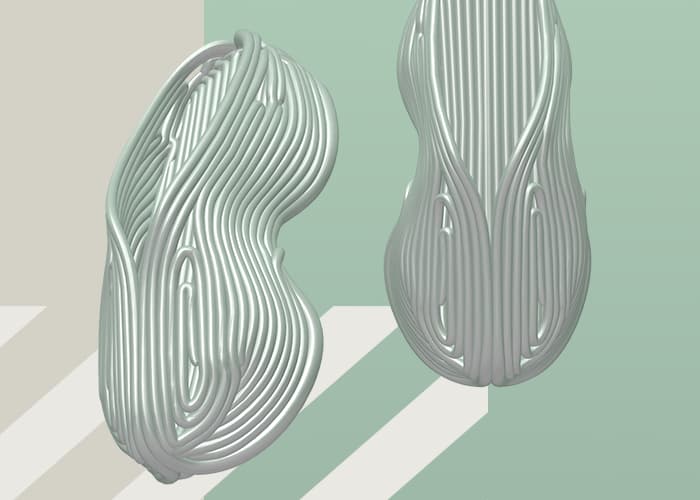In 1976, Issey Miyake opened a new retail space in the Shibuya District of Tokyo—an aluminum-lined interior where the abstract forms of the designer’s clothing were paired with postmodern structures and elevated industrial fixtures. The brains behind this new space was Miyake’s colleague and soon-to-be creative partner, Shiro Kuramata, a furniture designer known for his chairs fashioned from perforated metal, acrylic, and shimmering glass.
Perhaps it seemed only aesthetically important at the time, but this collaboration would go on to mark the beginning of an ongoing partnership between the worlds of Kuramata’s furniture and Miyake’s fashion, brought to life in many Issey Miyake stores and, on a larger scale, exemplified the creative romance and the altogether increasingly blurry line between furniture and apparel design.
Today, furniture is fashion’s newest frontier. Over the past decade, big names like Virgil Abloh, Rick Owens, and Samuel Ross now have well-known furniture collections to their names. Similarly, apparel by furniture designers and artists like Tom Sachs and Daniel Arsham is becoming highly sought after by collectors and sneakerheads alike.
It seems that furniture is a kind of fashion, or at least in the way the culture talks about it. In a recently-posted video tour of her new company office (designed by Tommy Clements and Waldo Fernandez in collaboration with Michèle Lamy of Rick Owens), Kim Kardarshian excitedly shares the furniture by Donald Judd and Rick Owens that she’s had installed in the space. The office is clad in a moodier take on the cream-colored interior of her home she once shared with Kanye West, whose influence can be seen in the office’s monochrome palette of beige-browns.
Watching the tour, one might get the sense that the function of the furniture feels less important than its role as an extension of Kim’s clothing itself. The warm wood grain of the Judd dining set and deep chocolates of the Rick Owens sofa, impressive but unobtrusive, play to the largely neutral palette of the Skims brand.
Rick Owens’ furniture too is at times seemingly indistinguishable from his apparel line, with sculptural seating and tables that seem more to be accessories to a larger aesthetic vision than simply functional objects for the home. This way of thinking—that furniture is not separate from fashion, but can inspire and excite in much the same manner—is swiftly taking a hold on both subculture and the mainstream alike.
So how did we get here? To understand the longstanding relationship between furniture and fashion, we can look to iconic figures from the history of design from the last fifty years and beyond as well as the tastemakers leading streetwear and luxury fashion’s infatuation with the discipline and begin to see how furniture has always been fashion’s family—clothing for the body meets clothing for the home.
Ten Creatives Blending the Worlds of Furniture and Fashion
Alessandro Mendini
Before Supreme was dressing objects, clothing, and nearly everything else in their signature red logo, Italian architect and designer Alessandro Mendi was remaking famous furniture designs with his own unique style of graphic and in-your-face color. Mendini’s habit of disrupting familiar pieces with his own style and vision is echoed in the work of designers and houses today like Balenciaga and Vetements, masters at interpreting everyday clothing and objects into something new and mind-altering.
Mendini has even designed for Supreme—you can purchase his work on their skate decks, ceramic trays, t-shirts, and even hoodies on StockX here.
Shiro Kuramata
Through his work with Issey Miyake, Kuramata’s high concept thinking and revolutionary use of materials left a lasting impact on the world of retail spaces. to lead the way in. More than just a place to sell clothes, Kuramata’s store designs were a complement to the clothes themselves. Similar directions can be seen today in stores like Nike and Acne, where every detail of the furniture and architecture builds the world of the brand itself.
Gaetano Pesce
An expert on design without genre, Italian designer and architect Gaetano Pesce’s work shows us that the lines between art, design, and perhaps even fashion are simply nonexistent: everything is made to be interesting, a “creative response to the needs of the time we live in.” At times it’s difficult to identify exactly what Pesce’s pieces are intended to do. He creates vessels that melt toward the floor and chairs that appear like massive jackets or capes, “dressing” the body of the sitter. Even when designing apparel, like his collaboration with plastic shoewear brand Melissa, his work tends to blend into a larger abstract vision that makes it as much as home on the body as it does in a gallery.
Zaha Hadid
A true renaissance woman, Zaha Hadid was a British-Iraqi furniture designer, architect, apparel designer, bringing a stunning vision of the future to every corner of her work and world. Beyond her contributions to architecture and unique seating designs like the Moon System and Z-Chair, Hadid collaborated with Pharrell on special editions of the Adidas Superstar and with LMVH’s Fendi and Louis Vitton on handbags.
Karim Rashid
If you were drawn to Frank Ocean’s Homer collection, you’ll love the work of Karim Rashid (Homer’s pendants were preceded by Rashid’s “symbols of life” in their Y2K-esque forms of representation). Born in Egypt and raised in Canada, the retrofuturistic designer’s furniture and interiors appear straight out of a TLC video, presenting designs that curve, bulge, and explode.
For Rashid, design is more than just furniture—it’s a way of life. “Design is about the betterment of our lives poetically, aesthetically, experientially, sensorially, and emotionally,” says Rashid in his “Karimanifesto,” an approach that can be seen not only in his wide array of furniture, but in his experimental shoe and apparel design, like these modular sneakers.
Virgil Abloh
When talking fashion-meets-furniture, there’s nowhere else to start but with Virgil. Known famously for his interdisciplinary design practices, Abloh left a legacy that trespassed the borders of couture, streetwear, graphic design, and furniture design, just to name a few of his expertises. Whatever it was, everything Abloh touched showed evidence of his unique vision, which emphasized his role as “maker” over “designer”—a maker of experiences, of statements, of new ways of thinking.
Abloh’s impact on the world of furniture was greatly felt, with his custom colorways for design powerhouse Vitra and aesthetically authentic designs for IKEA, the latter of which sells for 500% of the original asking price to designheads and sneakerheads alike. His furniture echoes the philosophy present through his work: that context and reinterpretation can make something entirely altogether new.
Tom Sachs
Though gaining notoriety for his work in the fine art world, the work of artist and designer Tom Sachs now touches furniture and apparel alike. With both Nike collabs and a chair collection to his name, Sachs’ work explores the aesthetics and ideas of Americana and craftsmanship. The emphasis on function in his clothing and furniture connects to parts of his sculptural work, often incorporating either functional appliances like speaker systems or rethinks the functionality of objects. His 2021-22 performance and exhibition “SPACE PROGRAM: RARE EARTHS” recreated space exploration activities and equipment at the Deichtorhallen Hamburg in Germany.
Samuel Ross
A protege of Virgil Abloh and standout designer in his own right, A-COLD-WALL’s Samuel Ross is no stranger to transferring his aesthetic vision from apparel to furniture. In 2019, the designer announced the launch of SR_A (Samuel Ross & Associates) in 2019, a creative studio working on projects in luxury industrial design, interior installation, architecture, furniture design, sound design and sculptural/visual communication. Ross’s furniture, much like his clothing, effortlessly blends the practical and the sculptural, with materials like Carrara marble paired with safety orange-colored steel.
Rick Owens
Though he can count fans of his furniture among pop culture trendsetters like Kim Kardashian, Rick Owen’s furniture, an ongoing collaboration with his wife Michele Lamy, has been accepted by the gallery world as well, with spaces like Carpenters Workshop Gallery displaying his pieces alongside well-known designers and artists like Vincent de Cotiis and Maarten Baas. In an interview with Architectural Digest, Owens described his furniture as “almost anti-cozy”—collectible pieces that “if you like it, you have to like it forever.” This collectibility and at times anti-practicality can be seen visually in many of his clothing pieces, with sculptural forms that cloak and envelop the body.
Daniel Arsham
Erosion can be seen in both the physical work and practice of Daniel Arsham, StockX’s artist-in-residence, both in the sense that Arsham’s signature presents itself as an erosion of familiar objects, and that his work continues to erode the barriers between genre and discipline. Arsham’s work, which touches everything from high fashion to furniture and includes high profile collaborations with Adidas, Rimowa, and Dior, invites its audience to question, “What is art? What is fashion? What is furniture?”
As the line between these worlds becomes less and less distinct, we can celebrate the opportunities created for those who are guided less by categorization than by a dream: a vision to create clothing and objects, both functional and not, that inspire and improve upon the human experience. That’s what design’s got to do with it.
David Eardley is a creative director, writer, and curator working in New York and Mexico City. He is the founder of Pink Essay, a creative studio and platform re-designing design culture through exhibitions, experiences, and archives. David’s curatorial work includes the OPEN STUDIO, Physical Education: Parallax 101, and Physical Education II: Design for All design exhibitions with Pink Essay, as well as his independently curated Home Around You and Unidades Materiales art and design exhibitions. David’s work and writing have been featured across The Wall Street Journal, Architectural Digest’s Clever, Office Magazine, Cloakroom Magazine, New York Magazine’s The Strategist, CURBED, and I-D.






